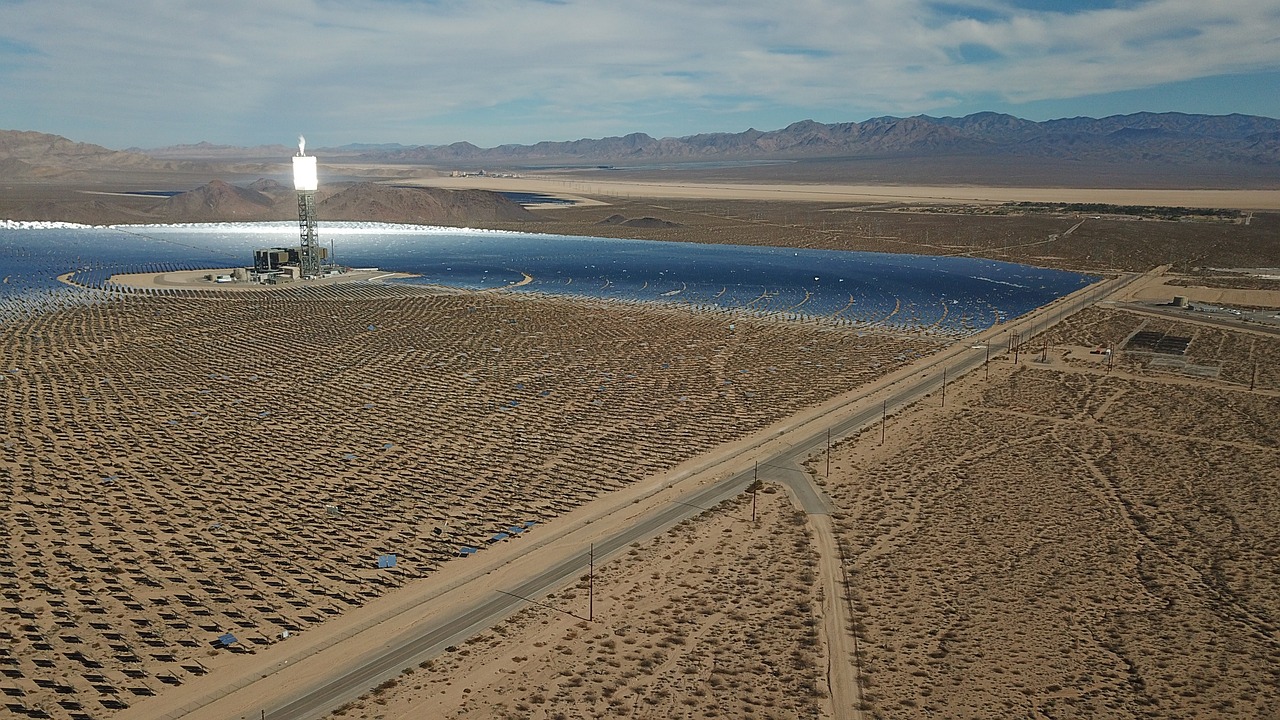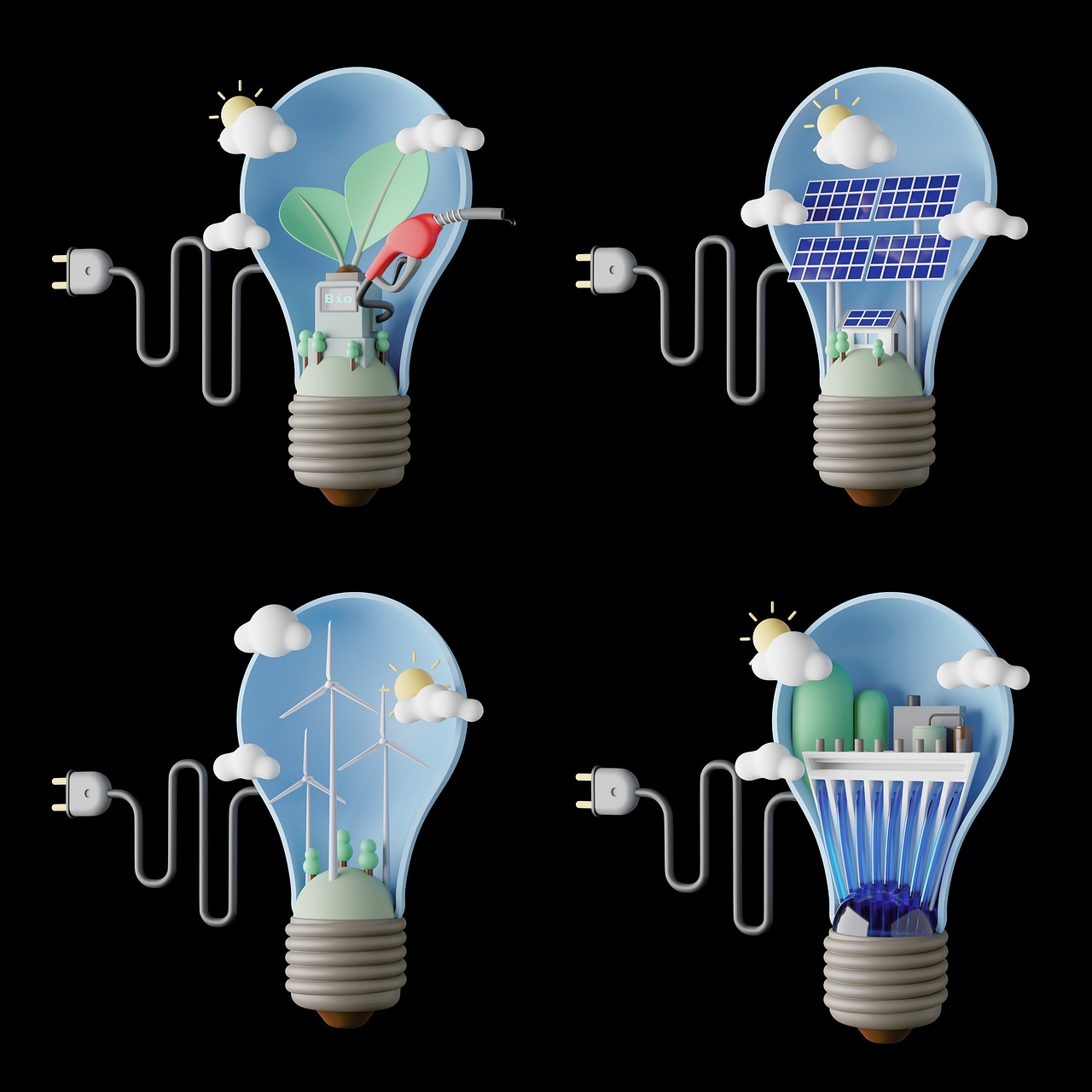Adopting Green Energy through Policies and Regulations
In today’s world, the urgency to shift towards green energy has never been more pressing. As we face the consequences of climate change, pollution, and dwindling fossil fuel reserves, the transition to sustainable energy sources is not just a choice; it’s a necessity. But how can we achieve this monumental shift? The answer lies in the implementation of effective policies and regulations that promote green energy adoption. These frameworks not only guide the development of renewable energy technologies but also create an environment where businesses and individuals feel empowered to invest in sustainable solutions.
Imagine a world where clean energy powers our homes, cars, and industries. This vision can become a reality through strategic governmental actions. By enacting laws that encourage the use of renewable resources like solar, wind, and hydroelectric power, governments can significantly impact the trajectory of energy consumption. However, the journey is filled with challenges and opportunities that require careful navigation.
One of the most critical roles of government is to provide a clear roadmap for the transition to green energy. This involves not only creating incentives for investment but also establishing a robust regulatory framework that addresses the complexities of energy production and distribution. For instance, by implementing Renewable Portfolio Standards (RPS), governments can mandate that utilities source a specific percentage of their energy from renewable resources. This drives demand and fuels innovation in green technologies.
Moreover, the adoption of net metering policies allows consumers who generate their own renewable energy, such as through solar panels, to receive credit for the excess energy they contribute to the grid. This not only incentivizes individuals to invest in renewable technologies but also fosters a culture of sustainability within communities.
However, transitioning to green energy is not without its hurdles. Political and economic resistance can pose significant challenges. Some stakeholders may prioritize immediate financial returns over long-term sustainability goals, creating a bottleneck in the adoption of green energy policies. Additionally, technological barriers, such as inadequate infrastructure and the need for advanced technologies, can slow down progress. Overcoming these challenges requires not just innovation and investment, but also a collective commitment from all sectors of society.
Ultimately, the journey towards adopting green energy through policies and regulations is a complex yet rewarding endeavor. By fostering an environment that encourages investment in renewable technologies and addressing the challenges head-on, we can pave the way for a sustainable future. The transition to green energy is not merely a policy choice; it’s a pathway to a healthier planet and a more sustainable way of life.
- What are the main benefits of adopting green energy? Green energy reduces greenhouse gas emissions, decreases dependence on fossil fuels, and promotes sustainable economic growth.
- How can individuals contribute to the green energy movement? Individuals can invest in renewable energy systems, support green policies, and reduce their energy consumption.
- What challenges do governments face in implementing green energy policies? Governments often encounter political resistance, funding limitations, and technological barriers that impede progress.

The Role of Government in Green Energy Adoption
When it comes to adopting green energy, the government plays a crucial role that can make or break the transition to sustainable energy sources. Think of the government as the architect of a grand building; without a solid blueprint, the structure is bound to face issues. Through effective legislation, incentives, and funding, governments can create a supportive environment that encourages the growth of renewable energy. In many countries, the government has taken significant steps to facilitate this transition, recognizing that the future of energy is not just about sustainability but also about economic resilience and environmental responsibility.
One of the primary ways governments can influence green energy adoption is through legislation. Laws that mandate the use of renewable energy sources can drive significant change. For example, many states have implemented Renewable Portfolio Standards (RPS), which require utilities to obtain a certain percentage of their energy from renewable sources. This not only boosts demand for clean energy but also encourages investment in innovative technologies. Without such mandates, many utilities might continue relying on fossil fuels, stalling progress towards a greener future.
Moreover, incentives are another powerful tool in the government's arsenal. Financial incentives such as tax credits and subsidies make renewable energy technologies more accessible for both businesses and individuals. Imagine a homeowner contemplating the installation of solar panels. If they know that they can receive a tax credit or grant to offset the costs, they are more likely to proceed with the project. This not only benefits the homeowner but also contributes to a broader goal of reducing carbon footprints and promoting cleaner air.
However, the role of the government doesn't end with incentives and regulations. Funding is equally critical. Governments can allocate funds for research and development in renewable technologies, helping to drive innovation. In addition, public funding can support projects that may not attract private investment due to perceived risks or long payback periods. For instance, consider a new wind farm project that requires substantial upfront investment. Government funding can bridge the gap, allowing such projects to come to fruition and paving the way for a future powered by clean energy.
In summary, the government acts as a catalyst for the adoption of green energy through its policies and regulations. By creating a favorable legislative environment, offering financial incentives, and investing in research and development, governments can significantly influence the pace of the transition to sustainable energy sources. The relationship between government actions and green energy adoption is akin to a dance; when both parties move in harmony, the result is a beautiful choreography towards a sustainable future.

Incentives for Renewable Energy Investment
When we talk about renewable energy investment, one of the most compelling aspects is the array of financial incentives that can significantly lower the barriers to entry for businesses and individuals alike. These incentives not only help to make renewable energy technologies more accessible but also create a ripple effect that encourages widespread adoption. Imagine you’re standing on the edge of a beautiful green valley, filled with potential, and the government is offering you a map that shows the best paths to get there—this is what these incentives represent.
Among the most effective incentives are tax credits and deductions. These financial tools can drastically reduce the upfront costs associated with renewable energy projects, making them an attractive option for many stakeholders. For instance, if you’re considering installing solar panels on your roof, a tax credit could offset a significant portion of that initial expense. This isn't just about saving money; it's about empowering individuals and businesses to take the leap into sustainable energy solutions.
Tax credits come in various forms, with some being available at the federal level while others can be found at the state level. Understanding the differences between these two is crucial for maximizing benefits. For example, the federal solar investment tax credit (ITC) allows you to deduct a significant percentage of your solar installation costs from your federal taxes. But state incentives can also play a pivotal role in enhancing the overall financial viability of renewable projects. This dual-layered approach can create a robust financial environment that fosters growth.
It’s essential to navigate the landscape of federal and state tax incentives wisely. While federal incentives provide a solid foundation, state programs can offer additional benefits tailored to local needs. For instance, some states may provide rebates or performance-based incentives that add even more value to your investment. Understanding how these different incentives work together can help you make informed decisions that align with your energy goals.
When considering incentives, it’s also important to evaluate the impact of long-term versus short-term incentives. Long-term incentives, such as feed-in tariffs or renewable energy certificates, can provide a steady revenue stream over time, making them appealing for large-scale projects. On the other hand, short-term incentives like immediate tax credits can help individuals and small businesses get started quickly. The choice between these options can be compared to deciding whether to invest in a long-term relationship or a quick fling; both have their merits, but your goals will dictate the best path forward.
In addition to tax incentives, there are various grants and funding opportunities available for green energy projects. These can come from government bodies, non-profit organizations, or even private sectors. Grants can provide essential financial support that enhances the viability and success of renewable energy initiatives. For instance, a grant might cover a substantial portion of the costs associated with research and development for new renewable technologies. This type of funding not only alleviates financial pressure but also encourages innovation, allowing entrepreneurs to explore groundbreaking ideas without the fear of financial ruin.
In conclusion, the landscape of renewable energy investment is rich with opportunities thanks to a variety of incentives designed to make the transition easier. By understanding and leveraging these financial tools, individuals and businesses can play a pivotal role in the shift towards a more sustainable future. The question remains: Are you ready to take advantage of these incentives and invest in a greener tomorrow?
- What types of tax credits are available for renewable energy investments? Tax credits vary by state and can include federal solar investment tax credits, wind energy production tax credits, and more.
- How do grants work for renewable energy projects? Grants provide funding that does not need to be repaid, often aimed at specific projects or research initiatives in renewable energy.
- Can I combine federal and state incentives? Yes, combining both can maximize your financial benefits, provided you comply with the specific regulations of each.
- What should I consider when choosing between long-term and short-term incentives? Consider your financial goals, the scale of your project, and how quickly you want to see returns on your investment.

Tax Credits and Deductions
When it comes to adopting green energy, one of the most effective tools in a stakeholder's arsenal is the availability of . These financial incentives can significantly reduce the initial costs associated with renewable energy projects, making them much more appealing to both businesses and individuals. Imagine wanting to install solar panels on your roof but hesitating due to the high upfront cost. Now, picture a scenario where you can claim a substantial portion of that cost back on your taxes. Sounds enticing, right?
Tax credits can be a game-changer. They directly reduce the amount of tax owed, which means more money stays in your pocket. For instance, if you invest $10,000 in a solar energy system and qualify for a 30% federal tax credit, you could reduce your tax bill by $3,000. That’s a significant saving that can be reinvested into your home or business. On the other hand, tax deductions lower your taxable income, which can also lead to savings, but often not as substantial as credits. Understanding these differences is crucial for anyone looking to dive into renewable energy.
However, it's essential to navigate the landscape of federal and state tax incentives effectively. Each state may have its own set of rules and benefits that can complement federal incentives. For example, some states offer additional tax credits or exemptions specifically for renewable energy investments, which can further enhance the financial viability of such projects. Below is a brief comparison of federal and state tax incentives:
| Type of Incentive | Federal Level | State Level |
|---|---|---|
| Tax Credits | 30% for solar, varying for wind | Varies by state (e.g., 10% in California) |
| Tax Deductions | Depreciation over 5 years | May offer additional deductions |
Another vital aspect to consider is the difference between long-term and short-term incentives. Long-term incentives, such as the federal Investment Tax Credit (ITC), are designed to encourage sustained investment in renewable energy technologies. In contrast, short-term incentives might be more appealing for immediate savings but could lack the long-term benefits necessary for significant investment. Stakeholders should carefully evaluate their options, considering their financial situation and long-term sustainability goals.
In conclusion, tax credits and deductions are not just numbers on a spreadsheet; they represent real opportunities for individuals and businesses to invest in a sustainable future. By understanding these incentives, you can make informed decisions that not only benefit your wallet but also contribute to a greener planet. So, are you ready to take the plunge into green energy?
- What are tax credits? Tax credits are amounts that taxpayers can subtract directly from the taxes they owe, making them a powerful incentive for renewable energy adoption.
- How do tax deductions differ from tax credits? Tax deductions reduce your taxable income, while tax credits reduce your tax bill directly.
- Are there state-specific tax incentives for renewable energy? Yes, many states offer their own tax credits and deductions that can complement federal incentives.
- How can I find out what incentives I qualify for? Check with your state’s energy office or a tax professional to understand the incentives available in your area.

Federal vs. State Tax Incentives
When diving into the world of renewable energy investments, understanding the differences between federal and state tax incentives is crucial for maximizing benefits. Each level of government offers its own set of incentives designed to encourage the adoption of green technologies, and navigating these can feel like a maze. Federal incentives typically provide a broad, nationwide framework, while state incentives can vary widely, reflecting local priorities and resources.
At the federal level, tax credits such as the Investment Tax Credit (ITC) and the Production Tax Credit (PTC) are well-known. The ITC allows investors to deduct a significant percentage of the cost of installing solar energy systems from their federal taxes. Meanwhile, the PTC offers a per-kilowatt-hour tax credit for electricity generated by qualified renewable energy sources. These federal incentives aim to create a uniform standard that can drive large-scale adoption of renewable technologies across the country.
On the flip side, state tax incentives can include property tax exemptions, sales tax exemptions, and even specific grants or rebates for renewable energy projects. For example, some states may offer a sales tax exemption for solar panels, making them more affordable at the point of purchase. Others might provide rebates that directly reduce the upfront costs of installation. This localized approach allows states to tailor their incentives to meet the specific needs of their residents while also addressing state energy goals.
To illustrate the differences further, consider the following table comparing federal and state incentives:
| Incentive Type | Federal Incentives | State Incentives |
|---|---|---|
| Investment Tax Credit (ITC) | Yes, significant percentage deduction | No |
| Production Tax Credit (PTC) | Yes, per-kWh credit | No |
| Property Tax Exemption | No | Varies by state |
| Sales Tax Exemption | No | Varies by state |
| Rebates | No | Available in some states |
It's also essential to note that while federal incentives provide a solid foundation, they may not always be sufficient for all renewable energy projects. This is where state incentives can play a pivotal role in bridging the gap. By leveraging both federal and state incentives, investors can significantly reduce their overall costs and boost the feasibility of their renewable energy initiatives. However, stakeholders must remain vigilant about the eligibility criteria and application processes for each incentive type to ensure compliance and maximize their benefits.
In conclusion, understanding the interplay between federal and state tax incentives is fundamental for anyone looking to invest in renewable energy. By strategically navigating these incentives, stakeholders can unlock significant financial benefits that not only make green energy projects more attainable but also contribute to a more sustainable future.
- What are the main federal tax incentives for renewable energy? The main federal tax incentives include the Investment Tax Credit (ITC) and the Production Tax Credit (PTC), which provide significant financial benefits for solar and wind energy projects.
- How do state tax incentives differ from federal ones? State tax incentives can vary widely and may include property tax exemptions, sales tax exemptions, and specific grants or rebates, tailored to meet local energy goals.
- Can I combine federal and state tax incentives? Yes, investors can often combine federal and state incentives to maximize their financial benefits, but it’s essential to understand the eligibility criteria for each.

Long-term vs. Short-term Incentives
When diving into the world of green energy, one of the most critical considerations is the type of incentives available for investment. It's essential to understand the difference between long-term and short-term incentives, as each plays a unique role in shaping the renewable energy landscape. Long-term incentives often include mechanisms such as feed-in tariffs or power purchase agreements that guarantee a stable price for energy produced over an extended period—think of it as planting a tree that will bear fruit for many years. On the other hand, short-term incentives, like immediate tax credits or rebates, provide quick financial relief, akin to a burst of energy that can help jumpstart a project.
Long-term incentives are particularly appealing for large-scale renewable energy projects, as they provide a sense of security and predictability in revenue streams. Investors can plan their finances with confidence, knowing that their investments will yield returns over time. For instance, if a solar farm enters into a 20-year power purchase agreement, it can forecast its earnings and plan for maintenance and upgrades accordingly. This stability can be a game-changer, especially for businesses looking to transition to renewable energy but hesitant due to financial uncertainties.
In contrast, short-term incentives are often more accessible for individuals and small businesses. These incentives can significantly reduce the upfront costs associated with renewable energy installations, making it easier for homeowners to install solar panels or purchase energy-efficient appliances. However, the challenge with short-term incentives is that they may not encourage sustained investment in renewable technologies. Once the incentive period ends, the motivation to invest might diminish, leading to a plateau in adoption rates.
To illustrate the differences, consider the following table that summarizes the key aspects of long-term and short-term incentives:
| Aspect | Long-term Incentives | Short-term Incentives |
|---|---|---|
| Duration | Several years to decades | One-time or short-term |
| Impact on Investment | Encourages large-scale projects | Stimulates immediate purchases |
| Financial Security | Provides stable revenue | Offers quick financial relief |
| Example | Power purchase agreements | Upfront tax credits |
Ultimately, the choice between long-term and short-term incentives depends on the specific goals of the stakeholders involved. Policymakers must consider how to balance these incentives to create a robust framework that encourages both immediate adoption and long-term commitment to renewable energy. By fostering an environment where both types of incentives coexist, we can ensure a sustainable transition to green energy that benefits everyone—like a well-tended garden that flourishes over time.
Q: What are long-term incentives in green energy?
A: Long-term incentives are financial mechanisms that provide stable returns over an extended period, encouraging investment in renewable energy projects.
Q: How do short-term incentives work?
A: Short-term incentives offer immediate financial benefits, such as tax credits or rebates, to encourage quick adoption of renewable energy technologies.
Q: Which type of incentive is better for small businesses?
A: Short-term incentives may be more beneficial for small businesses due to their immediate financial relief, allowing for quicker investments in renewable technologies.
Q: Can both long-term and short-term incentives coexist?
A: Yes, a balanced approach that incorporates both types of incentives can create a more effective strategy for promoting green energy adoption.

Grants and Funding Opportunities
When it comes to transitioning to renewable energy sources, securing adequate funding can often feel like searching for a needle in a haystack. However, the good news is that there are numerous available to support green energy projects. These financial resources are essential for individuals, businesses, and non-profits looking to invest in sustainable technologies. They not only lower the financial barrier to entry but also enhance the overall viability of renewable energy initiatives.
Grants are typically offered by various government agencies, non-profit organizations, and even private foundations. They can cover a wide range of expenses, including installation costs, research and development, and even educational programs aimed at promoting awareness about renewable energy. For instance, the U.S. Department of Energy provides several grant programs designed to support innovative energy projects that aim to reduce greenhouse gas emissions and improve energy efficiency.
To give you a clearer picture, here’s a brief overview of some common types of grants available:
- Federal Grants: These are funds provided by the federal government, often focusing on large-scale projects or research initiatives.
- State Grants: Many states have their own grant programs tailored to local needs, often focusing on community projects or small businesses.
- Private Grants: Various foundations and organizations offer grants to promote sustainability and innovation in renewable energy.
Moreover, funding opportunities are not limited to grants. Many organizations also provide low-interest loans and subsidies to encourage the adoption of renewable energy technologies. For example, programs like the Property Assessed Clean Energy (PACE) financing allow property owners to finance energy efficiency upgrades through their property taxes. This innovative approach makes it easier for homeowners to invest in solar panels or energy-efficient systems without a hefty upfront cost.
However, navigating the world of grants and funding can be daunting. It often requires a thorough understanding of eligibility criteria, application processes, and deadlines. Therefore, it’s crucial to conduct thorough research and possibly consult with experts who specialize in renewable energy funding. This can significantly increase your chances of securing the necessary financial support.
In summary, grants and funding opportunities play a pivotal role in the adoption of green energy. They not only alleviate financial burdens but also empower stakeholders to take actionable steps towards a sustainable future. If you’re considering a renewable energy project, don’t overlook the potential of these financial resources; they could be the key to turning your green energy dreams into reality.
1. What types of projects can be funded through grants?
Grants can fund a variety of projects, including solar panel installations, wind energy projects, energy efficiency upgrades, and educational programs about renewable energy.
2. How can I find available grants for renewable energy?
You can search for available grants through government websites, non-profit organizations, and private foundations that focus on sustainability and renewable energy initiatives.
3. Are there any application fees for grants?
Most grants do not have application fees, but it’s essential to read the guidelines of each grant carefully, as some may have specific requirements.
4. Can I apply for multiple grants for the same project?
Yes, you can apply for multiple grants, but be sure to check the terms and conditions of each grant to ensure compliance with their policies.

Regulatory Frameworks Supporting Green Energy
In the quest for a sustainable future, regulatory frameworks play a pivotal role in ensuring that green energy sources are not just viable but also competitive against traditional fossil fuels. These frameworks establish the rules and guidelines that govern how renewable energy is developed, integrated, and utilized within the energy market. Without a solid regulatory foundation, the transition to green energy could be stymied by uncertainty and inefficiency. So, what exactly do these frameworks entail, and how do they support the growth of renewable energy?
One of the most significant components of these frameworks is the establishment of Renewable Portfolio Standards (RPS). These standards require utilities to obtain a specified percentage of their energy from renewable sources. By mandating a minimum level of renewable energy, RPS creates a reliable market for green technologies, stimulating investment and innovation. For instance, if a state mandates that utilities must source 20% of their energy from renewables by 2030, it creates a clear target for energy producers. This not only generates demand for renewable technologies but also encourages utility companies to seek out innovative solutions to meet these standards.
Another crucial aspect is net metering policies. These policies allow consumers who generate their own electricity—through solar panels, for example—to receive credits for any surplus energy they feed back into the grid. This creates a win-win situation: consumers save on their energy bills while also contributing to the overall energy supply. Imagine a homeowner with solar panels generating more energy than they consume; with net metering, they can effectively "sell" that excess energy back to the utility, transforming their home into a small-scale power plant. This kind of policy not only incentivizes the installation of renewable energy systems but also fosters a sense of community involvement in energy production.
Moreover, robust regulatory frameworks also address critical issues such as grid access and interconnection standards. These regulations ensure that renewable energy producers can easily connect to the existing grid, allowing them to sell their energy without excessive barriers. In many regions, outdated infrastructure can be a significant hurdle for new renewable projects. By establishing clear interconnection standards, regulators can facilitate smoother transitions for new energy sources, ensuring that renewable energy can be efficiently integrated into the larger energy system.
However, it's not just about creating regulations; it’s also about environmental impact assessments. These assessments are crucial for evaluating the potential effects of renewable energy projects on local ecosystems. By requiring thorough evaluations, regulatory frameworks help ensure that green energy projects do not inadvertently harm the environment they aim to protect. This balance is essential for public acceptance and long-term sustainability.
In summary, regulatory frameworks are the backbone of green energy adoption. They set the stage for investment, innovation, and integration of renewable energy sources into our daily lives. Without these frameworks, the transition to a sustainable energy future would face significant hurdles. As we move forward, it’s crucial for policymakers to continually refine and enhance these regulations to keep pace with technological advancements and market demands.
- What are Renewable Portfolio Standards (RPS)? RPS are regulations that require utilities to obtain a certain percentage of their energy from renewable sources, promoting investment in green technologies.
- How does net metering benefit consumers? Net metering allows consumers to receive credits for excess energy they generate, reducing their energy bills and encouraging the use of renewable energy systems.
- Why are environmental impact assessments important? These assessments ensure that renewable energy projects do not harm local ecosystems, balancing sustainability with environmental protection.
- What role do regulatory frameworks play in green energy? They establish the rules and guidelines for energy production, integration, and usage, facilitating the growth and investment in renewable energy technologies.

Renewable Portfolio Standards
Renewable Portfolio Standards (RPS) are essential regulatory frameworks that require utility companies to obtain a specific percentage of their energy from renewable sources. This mandate not only encourages the shift towards green energy but also creates a competitive market for renewable technologies. Imagine a world where your electricity is sourced from the sun, wind, and water instead of fossil fuels. RPS makes this vision a reality by setting clear targets that utilities must meet, thus driving demand for renewable energy projects.
One of the most significant advantages of RPS is that it stimulates investment in renewable energy infrastructure. When utility companies know they have to meet certain benchmarks, they are more likely to invest in solar farms, wind turbines, and other renewable technologies. This not only helps in reducing greenhouse gas emissions but also fosters job creation in the green energy sector. For instance, a state with a robust RPS can see a surge in jobs related to the installation and maintenance of renewable energy systems, contributing positively to the local economy.
However, implementing RPS is not without its challenges. Utilities may face difficulties in integrating renewable sources into their existing grids. This is where the concept of interconnection standards comes into play, ensuring that renewable energy sources can be connected to the grid efficiently. Additionally, RPS can lead to increased energy costs in the short term, as utilities may pass on the costs of renewable energy investments to consumers. Nevertheless, the long-term benefits of reduced reliance on fossil fuels and the stabilization of energy prices make RPS a worthwhile endeavor.
To illustrate the effectiveness of RPS, consider the following table that outlines the percentage of renewable energy required by various states:
| State | Renewable Energy Target (%) | Year Implemented |
|---|---|---|
| California | 60% by 2030 | 2002 |
| New York | 70% by 2030 | 2019 |
| Texas | 30% by 2025 | 1999 |
| Massachusetts | 35% by 2030 | 2016 |
As seen in the table, states like California and New York are leading the way with ambitious targets that not only aim to reduce carbon emissions but also promote energy independence. By mandating these standards, states are essentially saying, “We believe in a sustainable future,” which resonates with both consumers and investors alike.
In conclusion, Renewable Portfolio Standards are a powerful tool in the transition to green energy. They create a structured approach for utilities to increase their renewable energy consumption, thereby fostering a cleaner environment and a more sustainable economy. As more states adopt and enhance their RPS, the vision of a world powered by renewable energy becomes increasingly attainable.
- What are Renewable Portfolio Standards? RPS are regulations that require utility companies to obtain a certain percentage of their energy from renewable sources.
- How do RPS benefit the environment? RPS help to reduce greenhouse gas emissions by promoting the use of clean energy sources.
- Are there any downsides to RPS? Implementing RPS can lead to short-term increases in energy costs and challenges in integrating renewable energy into existing grids.
- Which states have the most ambitious RPS? States like California and New York have set high renewable energy targets, aiming for 60% and 70% respectively by 2030.

Net Metering Policies
Net metering policies are a game-changer in the renewable energy landscape, allowing consumers who generate their own electricity from solar panels or other renewable sources to sell excess energy back to the grid. This not only empowers homeowners and businesses to take control of their energy consumption but also promotes a more sustainable energy future. Imagine producing more energy than you actually use and getting paid for it! How cool is that?
At its core, net metering works by giving customers credits for the surplus energy they contribute to the grid. These credits can then be used to offset future energy bills, effectively lowering the cost of electricity for those who invest in renewable energy technologies. This system encourages more people to consider solar and other renewable options, creating a ripple effect that can significantly increase the adoption of green energy. In fact, studies have shown that states with robust net metering policies often see higher rates of solar installation.
However, the specifics of net metering policies can vary widely from one state to another, leading to a patchwork of regulations that can confuse potential investors. For instance, some states offer generous credits for excess energy, while others have more restrictive policies that limit the amount of energy that can be net metered. To illustrate this point, here’s a simplified comparison of net metering policies in a few states:
| State | Net Metering Credit | System Size Limit |
|---|---|---|
| California | Retail Rate | Up to 1 MW |
| New York | Retail Rate | Up to 2 MW |
| Texas | Varies by Utility | No Limit |
As you can see, California and New York offer retail rate credits, making them attractive for solar investments. On the other hand, Texas has a more variable system that could lead to uncertainty for potential solar adopters. This inconsistency can create challenges for consumers trying to navigate their options, making it crucial for them to stay informed about the specific net metering policies that apply in their state.
Moreover, while net metering presents numerous advantages, it also faces challenges. Utility companies often argue that net metering can lead to revenue losses, which may result in higher costs for non-solar customers. This has sparked debates about how to balance the interests of solar users and those who rely on traditional energy sources. It's a classic case of trying to find harmony between innovation and existing systems.
In conclusion, net metering policies are vital for promoting the adoption of renewable energy. They not only incentivize consumers to produce their own energy but also contribute to a broader shift towards sustainable practices. As these policies evolve, they will play an essential role in shaping the future of energy consumption, making it imperative for stakeholders to engage in ongoing discussions and policy developments.
- What is net metering? Net metering is a billing arrangement that allows customers who generate their own electricity from renewable sources to receive credits for excess energy sent back to the grid.
- How does net metering benefit consumers? It allows consumers to lower their electricity bills by using credits for the energy they produce, making renewable energy systems more financially viable.
- Are net metering policies the same in every state? No, net metering policies vary by state, with different credit rates and system size limits.
- What challenges do net metering policies face? Challenges include potential revenue losses for utility companies and the need for a balanced approach that considers both solar users and traditional energy consumers.

Challenges in Implementing Green Energy Policies
Transitioning to green energy isn't just a walk in the park; it's more like climbing a mountain with various obstacles along the way. While the benefits of adopting renewable energy sources are clear, several challenges can hinder the effective implementation of green energy policies. These challenges can be broadly categorized into political and economic resistance, as well as technological barriers that need to be addressed.
One of the most significant hurdles is political and economic resistance. It's no secret that many stakeholders prioritize short-term gains over long-term sustainability goals. This often leads to a lack of political will to push green policies forward. For instance, traditional energy industries wield considerable influence, and their lobbying efforts can stall or even reverse progress toward renewable energy initiatives. Imagine trying to race a car with a flat tire; no matter how fast you want to go, you're stuck until that tire gets fixed. Similarly, without political support, green energy policies struggle to gain traction.
Moreover, the economic landscape plays a crucial role. In some regions, the initial investment required for renewable energy projects can be daunting. This is especially true for smaller businesses or individuals who might want to go green but feel overwhelmed by the upfront costs. It's like wanting to buy a fancy new gadget but hesitating because of the price tag. Until governments provide adequate financial incentives and support, many potential investors may hold back, fearing they won't see a return on their investment.
Another major challenge comes from technological barriers. The current infrastructure in many areas is not equipped to handle the demands of renewable energy sources. For example, the grid may not be able to support the influx of energy generated from solar panels or wind turbines. This is akin to trying to pour a gallon of water into a pint-sized cup; it simply won't work without spilling over. Additionally, the lack of advanced technologies can slow down the transition to green energy. Innovations are needed not just for energy generation, but also for storage and distribution. If we don't invest in cutting-edge technologies, we risk falling behind in the race toward sustainability.
To illustrate these challenges, consider the following table that highlights the key obstacles and their potential impacts:
| Challenge | Description | Impact |
|---|---|---|
| Political Resistance | Opposition from traditional energy sectors and lack of political will. | Slows down the adoption of green policies. |
| Economic Barriers | High initial costs and lack of financial incentives for small investors. | Limits participation in renewable energy projects. |
| Technological Limitations | Insufficient infrastructure and lack of advanced technologies. | Hinders effective energy distribution and storage. |
In summary, while the path to green energy adoption is paved with promise, it's also riddled with challenges that require attention and action. Overcoming political and economic resistance, as well as addressing technological barriers, is crucial for creating a sustainable energy future. It's not just about wanting to go green; it's about ensuring that the systems and policies in place support that transition effectively.
- What are the main challenges in implementing green energy policies?
The main challenges include political resistance, economic barriers, and technological limitations. - How can governments support green energy initiatives?
Governments can provide financial incentives, create supportive legislation, and invest in infrastructure improvements. - Why is political support crucial for green energy?
Political support can drive legislation and funding that facilitate the transition to renewable energy sources. - What role do technological advancements play in green energy?
Technological advancements are essential for improving energy generation, storage, and distribution, making renewable sources more viable.

Political and Economic Resistance
When we talk about the shift towards green energy, one of the biggest hurdles we face is the that often stands in the way. It's like trying to push a boulder uphill—no matter how much effort you put in, there are forces that seem determined to keep things as they are. This resistance can come from various sources, including politicians who may be swayed by lobbying from fossil fuel industries or those who prioritize short-term economic gains over long-term sustainability. The truth is, many stakeholders are hesitant to embrace change, fearing it might disrupt their established interests.
Political resistance often manifests in the form of legislation that favors traditional energy sources. For example, subsidies for coal and oil can create an uneven playing field, making it challenging for renewable energy companies to compete. It's as if we’re in a race where one runner is allowed to start ahead of the others while the rest are stuck at the starting line. This favoritism not only stifles innovation but also sends a message that the government is not fully committed to the green energy transition.
On the economic front, there are concerns about the initial costs associated with renewable energy investments. Many businesses and individuals worry that the transition to greener technologies will be too expensive. While it's true that the upfront costs of solar panels or wind turbines can be daunting, the long-term savings and benefits often outweigh these initial investments. However, the fear of high costs can lead to a lack of investment in green technologies, further perpetuating reliance on fossil fuels.
It's also worth noting that the economic landscape is often influenced by global market trends. For instance, fluctuations in oil prices can lead to a temporary decline in interest in renewable energy. When oil is cheap, people may think, "Why bother investing in solar when I can fill up my tank for less?" This short-sighted view can delay the transition we desperately need. To combat this, we need to create a more stable and predictable market for renewable energy, which can be achieved through robust policies and regulations.
In summary, overcoming political and economic resistance is crucial for the advancement of green energy initiatives. It requires a concerted effort from governments, businesses, and individuals alike. We need to advocate for policies that level the playing field, provide financial incentives, and educate the public about the long-term benefits of renewable energy. Only then can we hope to create a sustainable future where green energy is not just an alternative, but the norm.
- What are the main barriers to adopting green energy?
Political resistance, economic concerns, and technological limitations are the primary barriers. - How can governments encourage green energy adoption?
By implementing supportive policies, providing financial incentives, and investing in renewable energy infrastructure. - What role do individuals play in the transition to green energy?
Individuals can advocate for change, invest in renewable technologies, and reduce their carbon footprint.

Technological Barriers
Transitioning to green energy isn't just about having the willpower or the right policies; it also hinges significantly on the technology at our disposal. One of the major hurdles we face in this journey is the presence of various that can slow down or even stall the adoption of renewable energy. Imagine trying to drive a car with a flat tire; no matter how determined you are to reach your destination, that flat tire is going to hold you back. Similarly, without the right technological advancements, our progress toward a sustainable energy future can be severely hampered.
One of the primary technological barriers is the insufficient infrastructure to support renewable energy sources. For instance, while solar panels and wind turbines are becoming more common, the grid that distributes this energy often struggles to keep pace. Many areas lack the necessary transmission lines and storage solutions to handle the influx of renewable energy, leading to inefficiencies and wasted potential. This is akin to trying to pour water into a cup that has too many holes; no matter how much you pour, it just won’t hold!
Moreover, there’s a significant lack of advanced technologies in some regions. While places like Silicon Valley are buzzing with innovation, other areas may still rely on outdated systems that can’t support new energy technologies. This disparity creates a technological divide, making it difficult for some communities to access the benefits of renewable energy. For instance, if a community wants to implement solar energy solutions, but lacks the technology to efficiently store or distribute that energy, their efforts may be in vain.
Additionally, the cost of technology can be a barrier in itself. Although prices for renewable technologies like solar panels have decreased significantly over the years, the initial investment can still be daunting for many. Small businesses and homeowners may find it challenging to afford the upfront costs associated with installing renewable energy systems. To illustrate this, consider a small business owner who wants to invest in solar panels. They may recognize the long-term savings on energy bills, but the initial expense can feel like a mountain too steep to climb.
In conclusion, addressing these technological barriers is crucial for the successful transition to green energy. We need to invest in modernizing our infrastructure, ensuring that advanced technologies are accessible to all, and finding ways to reduce the cost of renewable energy systems. Only then can we hope to create a future where green energy is not just a dream, but a reality for everyone.
- What are the main technological barriers to green energy adoption?
The main barriers include insufficient infrastructure, lack of advanced technologies, and high initial costs for renewable energy systems. - How can governments help overcome these barriers?
Governments can invest in infrastructure improvements, provide funding for research and development, and offer incentives to reduce the cost of renewable technologies. - Why is infrastructure important for renewable energy?
Infrastructure is crucial because it supports the distribution and storage of energy generated from renewable sources, ensuring that it can be used efficiently.
Frequently Asked Questions
- What are the main benefits of adopting green energy?
Adopting green energy can lead to numerous benefits, including reduced greenhouse gas emissions, lower energy costs in the long run, and enhanced energy security. Furthermore, it promotes job creation in the renewable energy sector and helps combat climate change, ensuring a healthier planet for future generations.
- How do government policies influence green energy adoption?
Government policies play a crucial role in green energy adoption by providing incentives, funding, and establishing regulatory frameworks. These policies can drive investment in renewable technologies, making them more accessible and appealing to businesses and individuals alike.
- What types of financial incentives are available for renewable energy projects?
There are various financial incentives available, including tax credits, grants, and subsidies. Tax credits can significantly lower the upfront costs, while grants provide essential funding for project development. These incentives can make renewable energy projects more financially viable and attractive.
- What is the difference between federal and state tax incentives?
Federal tax incentives are offered at the national level and can apply to a wide range of renewable energy projects. State tax incentives, on the other hand, vary by state and may provide additional benefits tailored to local needs. Understanding both can help maximize the financial advantages of green energy investments.
- What are Renewable Portfolio Standards (RPS)?
Renewable Portfolio Standards (RPS) are regulations that require utilities to obtain a certain percentage of their energy from renewable sources. This drives demand for green energy technologies and encourages utilities to invest in sustainable energy solutions.
- What challenges are associated with implementing green energy policies?
Implementing green energy policies can face several challenges, such as political resistance, funding limitations, and technological barriers. These issues can hinder the effective transition to renewable energy, requiring innovative solutions and strong commitment from stakeholders to overcome them.
- How can net metering policies benefit consumers?
Net metering policies allow consumers to receive credit for excess energy generated by their renewable systems, such as solar panels. This incentivizes the installation of renewable technologies by making them more financially attractive and can lead to significant savings on energy bills.



















